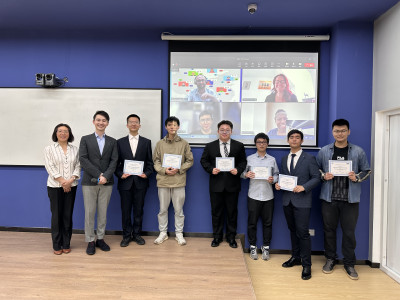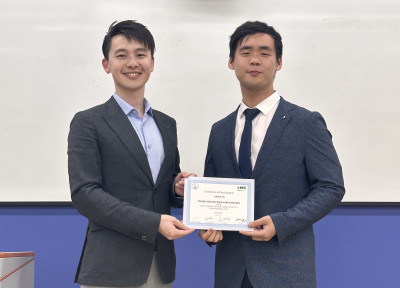News
2023 Chinese Final of the IOM3 Young Persons' Lecture Competition
2 June 2023


The IOM3 Young Persons’ Lecture Competition (YPLC) is an annual event organized by the Institute of Materials Minerals and Mining (IOM3). The YPLC invites students and professionals up to the age of 28 to deliver a short presentation (12 to 15 minutes) on a topic related to materials, minerals, mining, packaging, clay technology, wood science or engineering, more information can be found at the IoM3 website here.
Candidates compete in a series of local heats organized by IOM3 co-ordinators, from which the regional or national finalists are selected. The winners of each heat go on to compete in the Yong Persons’ World Lecture Competition (YPWLC), more information on which can be found here.
Last week, the third YPLC Chinese national heat was hosted by Queen Mary University of London’s Engineering School in Xi’an, China (QMES). The winner of which will be invited to represent China in the YPWLC which will be held online on Wednesday 8 November.
In the 2023 Chinese national final seven talented young scientists and engineers delivered their presentation to a hybrid audience (face-to-face and online). The event was opened with a short introduction by the IoM3 coordinator and event Chairman, Andrew Spowage, and then the contestants took over the show. A summary of the presenters and their topics is given below (in the order they were presented in) , details of the presentations along with links to their slides and presentations can be found at the end of this article:
- Chuan Yu : Novel Energy Absorption Structure based on 3D Printed Polymer Blend System
- Yixuan Zhang : Synthesis of thermally stable metallic phase MoSe2 for sodium ion storage
- Haoyan Chen : One-Dimensional Barium Titanate Nanoarrays for the Treatment of Tumorous Bone Defects
- Jiakai Li : Oxygen Vacancy Modulation of CeO2 and the Impact on the Catalytic Performances
- Jiaming Liu : Multi-Scale Modeling of Composite Materials
- Qingyuan Guo : A Mitochondrial-Targeted H2O2-Responsive Fluorogenic Probe for Evaluating Hepatic Ischemia-Reperfusion Injury
- Yuxuan Jiang : Mechanism study on stress-induced phase transformation of 304 gradient stainless steel
There are more details about each of our outstanding finalists at the end of this document. All presentations were well received, and spirited questions raised about the wide range of exciting research areas. After the final presentation the judges Faith Nightingale, Han Zhang and Li Wang took a side bar and held very heated discussions to define the winners. I
Dr Andrew Spowage is quoted as saying that “he has been witness to voting in several competitions around the world and this one was the closest”
In the end only a handful of points separated the contenders. The various prizes awarded were as follows:
- 1st Place – Mr Chuan Yu who will receive a cash prize, a certificate and an invitation to the YPWLC in November
- 2nd Place – Mr Yixuan Zhang who will receive a cash prize and a certificate
- 3rd Place- Mr Qingyuan Guo who will receive a cash prize and a certificate
Further Information:
- For more Information about the Young Persons’ World Lecture Competition
- For more information on Queen Mary University of London Engineering School, Xi’an, the host of the event
- For more information on the work, activities, and membership of IOM3
- If you, your students or colleagues would like to participate in next years’ Chinese National Finals of the Young Persons’ Lecture Competition please contact Dr Andrew Spowage (a.spowage@qmul.ac.uk)
Details of the Finalists:
(in the order the presentations were delivered)
Chuan Yu’s (photo, slides, recording)
- Current age: 22
- Year of study: 2019
- What you plan to do after you graduate: Continue a Master degree
- Area of Interest: Biomaterial, Composite material, 3D Printing
Abstract
Energy absorption structure (EAS) is a type of material system designed to absorb high kinetic mechanical energy through irreversible deformation, which is widely used in many applications. This research project selected Fused Deposition Modelling (FDM) method to build up different EAS with a TPU-PVDF polymer blend system. Totally, there are two design strategies used in this project: the gradient configuration design where the EAS is given a gradient structure and the hierarchical design where multi-scale pores are introduced into the EAS. The success of the two designs in this project strongly depends on the application of FDM 3D printing method whose specific processing procedure will be given in this presentation, together with the performance of the EAS created to evaluate the design strategies used.
Yixuan Zhang’s presentation (photo, slides, recording)
- Current age: 21
- Year of study: senior
- What you plan to do after you graduate: pursue master's and doctoral studies
- Area of Interest: batteries, energy storage devices
Abstract
In this work, 1T-MoSe2/C is synthesized via ethylene glycol (EG) molecular intercalation, from which it can in-situ convert into a conductive carbon framework during the pyrolysis process and form Mo-O-C bonds. These can regulate the maximum 1T phase as high as 80.3%, with an interlayer spacing of 0.86 nm; the bonds furthermore inhibit the restacking of MoSe2 layers and provide strong interface electronic coupling in the 1T-MoSe2/C heterostructure, enabling a stable structure and fast pseudocapacitive Na+ storage.
Haoyan Chen’s (photo, slides, recording)
- Current age: 28
- Year of study: 2nd PhD
- What you plan to do after you graduate: Ortheopedic surgeon
- Area of Interest: Surface modification of titanium implant materials applied in orthopedics to improve surgical instruments and methods
Abstract
The current therapeutic implants fail to selectively suppress tumor growth and enhance osteogenesis, and antitumor therapy may compromise osseointegration of the bone implant. Based on the different responses of bone tumor cells and osteoblasts to different electric stimulations, we constructed ferroelectric BaTiO3 nanorod arrays (NBTO) ontitanium implants surface with switchable dynamic and static electrical stimulation for selective bone-tumor therapy and bone tissue regeneration. Polarized NBTO (PNBTO) generated a sustained dynamic electrical stimulus in response to wireless ultrasonic irradiation, which disrupted the orientation of the spindle filaments of the tumor cell, blocked the G2/M phase of mitosis, and ultimately led to tumor cell death. Under the switch-off state, PNBTO with a high surface potential provided static electrical stimulation, accelerating osteogenic differentiation and enhancing the quality of bone regeneration both in vitro and in vivo.
Jiakai Li’s (photo, slides, recording)
- Current age: 21
- Year of study: 4th
- What you plan to do after you graduate: Continue further study
- Area of Interest: Catalysis, semiconductor
Abstract
Aniline is an important chemical raw material. The catalytic hydrogenation of nitrobenzene is a kind of method to produce aniline which has the advantages of high efficiency, good safety, and simple operation. All these above made it one of the most promising methods for large-scale production of aniline. Choosing catalysts with low cost, high selectivity and activity is crucial. We can solve this problem by studying the effect of Pr-doping on the regulation of oxygen vacancies in CeO2 carriers. Research has found that Pr-doping can significantly increase the oxygen vacancy concentration of CeO2. The catalytic hydrogenation yield of Pt/CeO2 is also raised from 33.6% to 82.1% because of this, which means the cost of producing aniline can be reduced through Pr-doping.
Jiaming Liu’s (photo, slides, recording)
- Current age: 21
- Year of study: 3rd
- What you plan to do after you graduate: Continue further study
- Area of Interest: Mechanical engineering, Robotics, Materials Science
Abstract
Multi-scale modeling has emerged as a powerful approach to understanding the mechanical behavior of composite materials at different scales. This talk will present a review of the multi-scale modeling techniques employed in the analysis of composite materials. The aim is to provide an insight into the complex interactions between fiber, matrix, and interphase, and their influence on the overall properties of a composite. The content encompasses various modeling approaches, including micro-mechanics, mesoscale modeling, and macro-scale finite element analysis. Key aspects such as the representation of microstructure, material properties, and the development of constitutive models are discussed. The advantages and limitations of each modeling approach are highlighted, along with their applications in predicting the mechanical properties, deformation, and failure behavior of composite materials.
Qingyuan Guo’s (photo, slides, recording)
- Current age: 21
- Year of study: 4th
- What you plan to do after you graduate: become an engineer
- Area of Interest: molecular imaging
Abstract
Assessing mitochondrial H2O2 in HIRI could provide a valuable opportunity for early warning and timely intervention. Therefore, we proposed a mitochondria-targeted fluorogenic probe (Mito-WG) for tracking the changes of mitochondrial H2O2 in HIRI. The reaction products of the fluorogenic probe and H2O2 provide fluorophore for near-infrared detection and the ability of mitochondria targeting. Moreover, this molecule not only exhibited a sensitive response to mitochondrial H2O2 level, but also presented selective detection on mitochondrial H2O2 compared with other interfering molecules in mitochondria. The density functional theory (DFT) calculation method incorporated with HPLC analysis confirmed the sensing mechanism of “Turn-On” fluorescence response. The confocal microscopic imaging revealed that the probe can be used to assess the correlation between mitochondrial H2O2 levels and the severity of liver injury during HIRI. It is expected that Mito-WG could be a potential candidate.
Yuxuan Jiang’s (photo, slides, recording)
- Current age: 22
- Year of study: 4th
- What you plan to do after you graduate: I would be doing my postgraduate studies in the MPhil programme in Cambridge.
- Area of Interest: electrode modification of ion batteries
Abstract
In response to the progressively diverse and complex requirements on the functions of metallic materials, research into gradient materials is currently on the rise. Processing 304 stainless steel into gradient nano-grained structure could combine the high toughness of coarse grains and high strength of fine grains to further enhance the alloy. However, the mechanism of strain-induced phase transformation during the strengthening process has not been thoroughly studied due to the limitation of characterization apparatus. Molecular dynamics (MD) simulation is applied to reveal the microscopic mechanism at the molecular or atomic level in the article. The project managed to unravel the mechanism of phase transformation during the indentation and scratching process of gradient 304 stainless steel and presented some mechanical properties tested during the processes.
hanical properties tested during the processes.
| Contact: | Andrew Spowage |
| Email: | a.spowage@qmul.ac.uk |
| Website: | |
| People: |
Updated by: Andy Spowage

